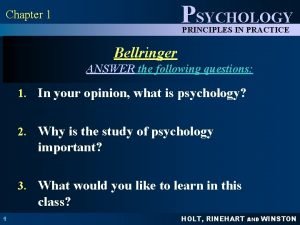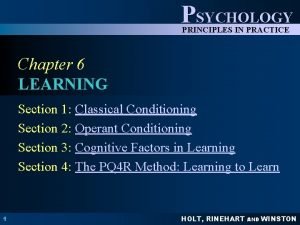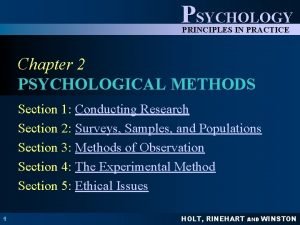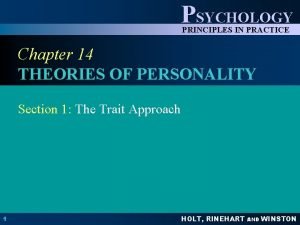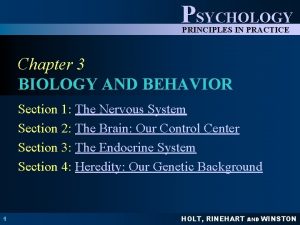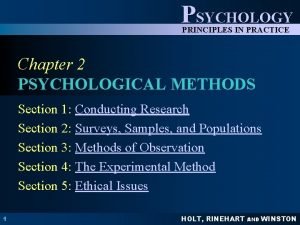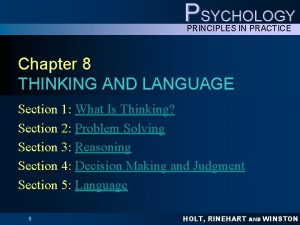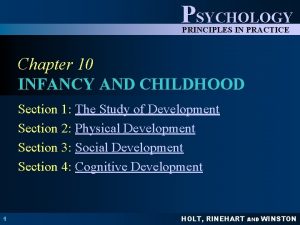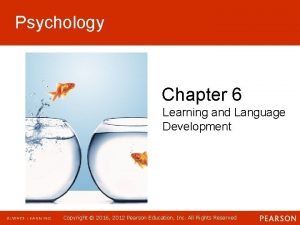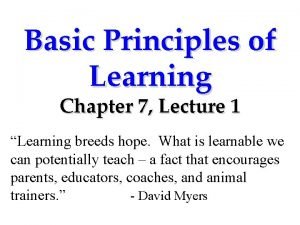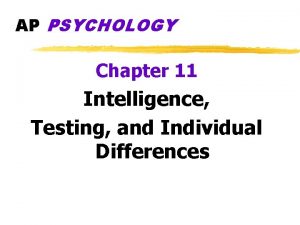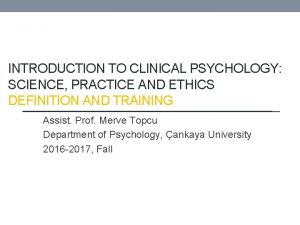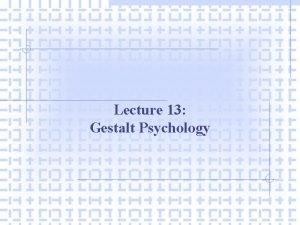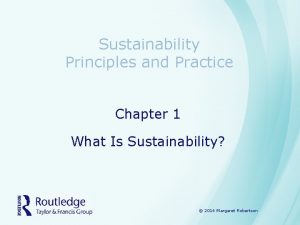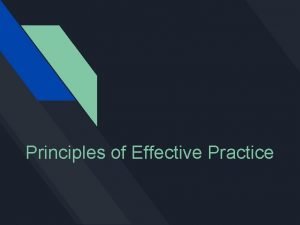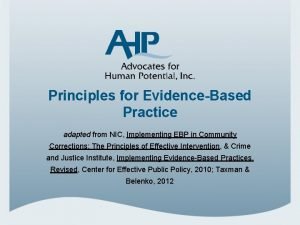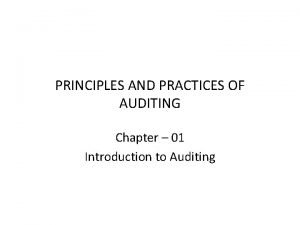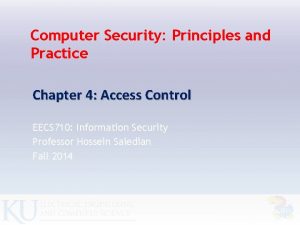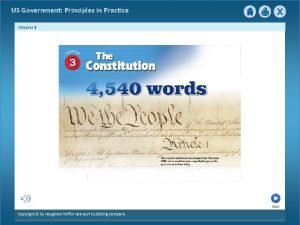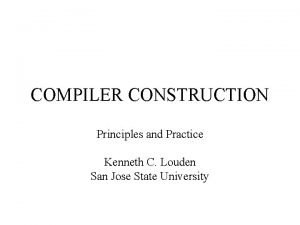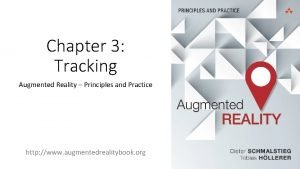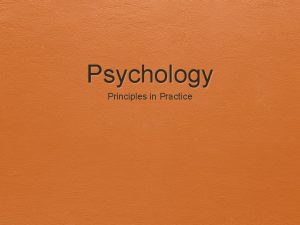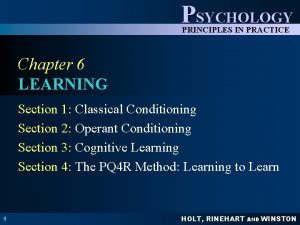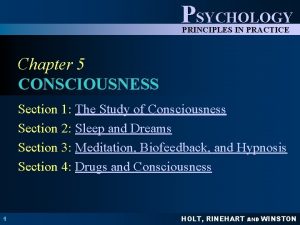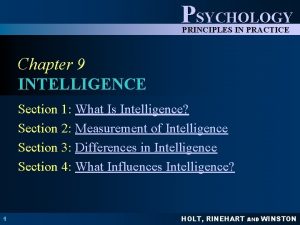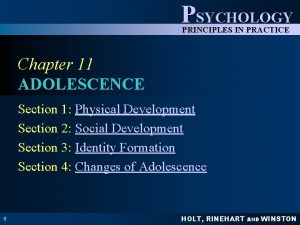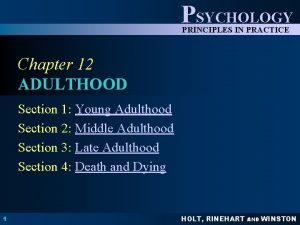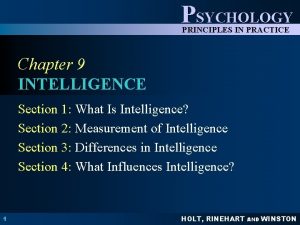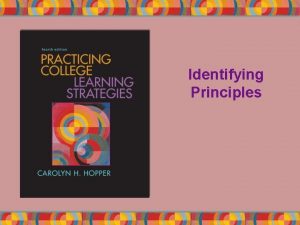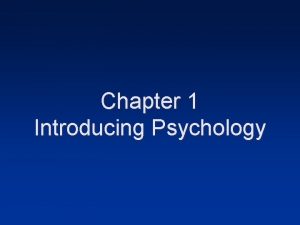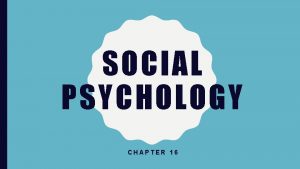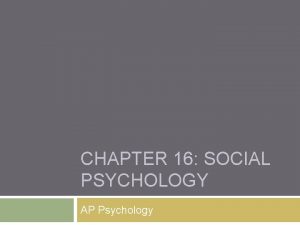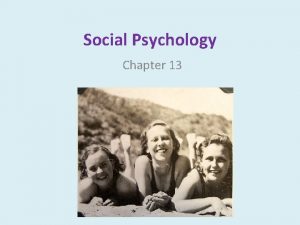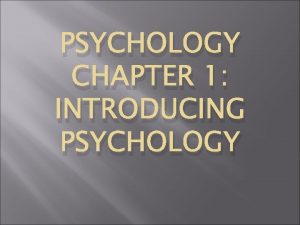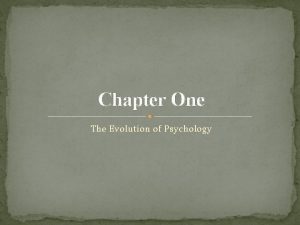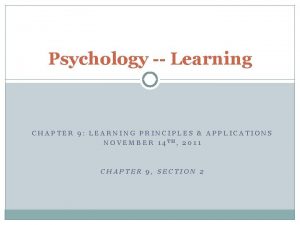PSYCHOLOGY PRINCIPLES IN PRACTICE Chapter 6 LEARNING Section






































- Slides: 38

PSYCHOLOGY PRINCIPLES IN PRACTICE Chapter 6 LEARNING Section 1: Classical Conditioning Section 2: Operant Conditioning Section 3: Cognitive Factors in Learning Section 4: The PQ 4 R Method: Learning to Learn 1 HOLT, RINEHART AND WINSTON

Chapter 6 PSYCHOLOGY PRINCIPLES IN PRACTICE Section 1 - Classical Conditioning n Journaling 2 HOLT, RINEHART AND WINSTON

Chapter 6 PSYCHOLOGY PRINCIPLES IN PRACTICE n Stimulus- Something that triggers a response. For example, touching a hot surface would be the stimulus to remove your hand from that surface. Anything that elicits or affects a behavioral response n Conditioning- learning that involves stimulus-response connections, in which the response is conditional on the stimulus 3 HOLT, RINEHART AND WINSTON

Chapter 6 PSYCHOLOGY PRINCIPLES IN PRACTICE Ivan Pavlov ( 1849 -1936) n Dogs learn to associate one thing with another when n n 4 food is involved Was interested in the relationship between the nervous system and digestion- was studying salivation Discovered that dogs did not always wait until they had received meat to start salivating. Ex- they salivate in response to the clinking of food trays, or when the assistants entered the laboratories Why? Dogs learned from experience that these events mean food was coming HOLT, RINEHART AND WINSTON

Chapter 6 PSYCHOLOGY PRINCIPLES IN PRACTICE n Pavlov wanted to know if the dogs could learn to n n 5 salivate in response to any stimulus that signaled meat Set out to show that he could train his dogs to salivate in response to any stimulus he picked Stimulus= ringing of a bell Rang the bell then put meat powder on dogs tongues Dogs salivate in response to the meat powder placed on tongues HOLT, RINEHART AND WINSTON

Chapter 6 PSYCHOLOGY PRINCIPLES IN PRACTICE n Repeats process several times n Changes the procedure- rings the bell and doesn’t follow with meat powder n What happens? n The dogs salivated anyway, learned to salivate in response to only the bell 6 HOLT, RINEHART AND WINSTON

Chapter 6 PSYCHOLOGY PRINCIPLES IN PRACTICE 7 HOLT, RINEHART AND WINSTON

Chapter 6 PSYCHOLOGY PRINCIPLES IN PRACTICE n Pavlov’s Experiment n http: //www. youtube. com/watch? v=hhqumfpxuz. I 8 HOLT, RINEHART AND WINSTON

Chapter 6 Section 1: Classical Conditioning PSYCHOLOGY PRINCIPLES IN PRACTICE IMPORTANT TERMS Terms that are important in understanding classical conditioning: n Unconditioned stimulus (US) – a stimulus that causes a response that is automatic, not learned n Unconditioned response (UR) – the response that is automatic, not learned 9 HOLT, RINEHART AND WINSTON

Chapter 6 Section 1: Classical Conditioning PSYCHOLOGY PRINCIPLES IN PRACTICE Question: What are the principles of classical conditioning? IMPORTANT TERMS (continued) n Conditioned Stimulus (CS) – a previously neutral stimulus that, because of pairing with an unconditioned stimulus, now causes a conditioned response n Conditioned Response (CR) – a learned response to a stimulus that was previously neutral or meaningless 10 HOLT, RINEHART AND WINSTON

Chapter 6 PSYCHOLOGY PRINCIPLES IN PRACTICE n What were the unconditioned stimulus, unconditioned response, and conditioned stimulus in Pavlov’s experiment? n Write in your notes! 11 HOLT, RINEHART AND WINSTON

Chapter 6 PSYCHOLOGY PRINCIPLES IN PRACTICE n US= meat powder n UR= salivate n CS= ringing bell n CR= salivate 12 HOLT, RINEHART AND WINSTON

Chapter 6 PSYCHOLOGY PRINCIPLES IN PRACTICE Adapting to the Environment n Classical conditioning helps organisms adapt to their environment: n Taste Aversion n Extinction n Spontaneous Recovery n Generalization and Discrimination 13 HOLT, RINEHART AND WINSTON

Chapter 6 PSYCHOLOGY PRINCIPLES IN PRACTICE n Taste Aversion- learned avoidance of a particular food n Eating too much ice cream at once: Ice cream (US), that caused the nausea (UR). As a result even the thought of ice cream serves as a CS that can make you feel nauseous (CR) 14 HOLT, RINEHART AND WINSTON

Chapter 6 PSYCHOLOGY PRINCIPLES IN PRACTICE Extinction When a conditioned stimulus is no longer followed by an unconditioned stimulus it eventually looses its ability to bring about a conditioned response n The conditioned stimulus (CS) no longer causes the conditioned response (CR) to occur n Pavlov found that eventually the ringing of the bell followed by no meat caused the dogs to eventually stop salivating- the conditioned response has been extinguished 15 HOLT, RINEHART AND WINSTON

Chapter 6 PSYCHOLOGY PRINCIPLES IN PRACTICE Spontaneous Recovery n When organisms display responses that were extinguished earlier n A rest period takes place (the dogs have not heard the bell for two or three days) n Then when they hear the bell again, they salivate-the response is back but weaker (less saliva) 16 HOLT, RINEHART AND WINSTON

Chapter 6 PSYCHOLOGY PRINCIPLES IN PRACTICE Generalization and Discrimination n Generalization- the act of responding in the same ways to stimuli that seem to be similar even if the stimuli are not identical n Ice cream caused taste aversion- Feel the same way about ice cream of any flavor even if the first one that made you nauseous was chocolate 17 HOLT, RINEHART AND WINSTON

Chapter 6 PSYCHOLOGY PRINCIPLES IN PRACTICE n Discrimination- the act of responding differently to stimuli that are not similar to each other n After taste aversion to ice cream (which was chocolate) you will not have the same reaction to chocolate pudding, chocolate cake, choc. milk, etc. n Able to discriminate between the two because they are very different from each other 18 HOLT, RINEHART AND WINSTON

Chapter 6 PSYCHOLOGY PRINCIPLES IN PRACTICE Applications of Classical Conditioning n Classical conditioning can help people overcome n n 19 fears Flooding- person is exposed to harmless stimulus until fear responses to that stimulus are extinguished Fear of heights- taken to tops of tall buildings Effective but very unpleasant Psychologists prefer a different method… HOLT, RINEHART AND WINSTON

Chapter 6 PSYCHOLOGY PRINCIPLES IN PRACTICE n Systematic desensitization- people are taught relaxation techniques then while they are relaxed they are exposed gradually to the stimulus they fear n Goal is to teach the person how to cope with their fears n Ex: someone who fears snakes is shown pictures of snakes, once the person can do this without losing the feeling of relaxation he or she might be shown a real snake from a distance, then after this the snake will be brought closer and closer n Eventually the point is to no longer fear snakes 20 HOLT, RINEHART AND WINSTON

Chapter 6 PSYCHOLOGY PRINCIPLES IN PRACTICE n Systematic desensitization takes longer than flooding but it not as unpleasant for the person n Counterconditioning- reducing fear by repeatedly pairing a pleasant stimulus with a fearful one, counteracting the fear n Child is afraid of a rabbit. Give cookies while the rabbit comes closer and closer. Eventually able to pet the rabbit while eating cookies. Pleasure at eating cookies cancels out the fear of rabbits. 21 HOLT, RINEHART AND WINSTON

Chapter 6 PSYCHOLOGY PRINCIPLES IN PRACTICE 22 HOLT, RINEHART AND WINSTON

Chapter 6 Section 2: Operant Conditioning PSYCHOLOGY PRINCIPLES IN PRACTICE OPERANT CONDITIONING n Another type of learning besides classical conditioning is operant conditioning n Operant Conditioning- People and animals learn to do certain things because of the results of what they do n Learn from the consequences of their actions n There are both positive consequences and negative ones 23 HOLT, RINEHART AND WINSTON

Chapter 6 PSYCHOLOGY PRINCIPLES IN PRACTICE n In classical conditioning the responses are often involuntary (salivating) n In operant conditioning responses are voluntary (we have control over them) n Example: studying- you do it because of its consequences, usually better grades. It is conditioned. 24 HOLT, RINEHART AND WINSTON

Chapter 6 PSYCHOLOGY PRINCIPLES IN PRACTICE B. F. Skinner- “Skinner Box” n. Rat in the box is deprived of food. When a lever is pressed some food pellets would drop into the box. The rat accidentally pressed the lever and food came out. Soon the rat learned that its behavior was producing the food. n. Reinforcement – the process by which a stimulus increases the chances that the preceding behavior will occur again n. After several reinforced responses the rat pressed the level quickly and frequently until it was no longer hungry n. Teaching your dog to sit with treats works this way 25 HOLT, RINEHART AND WINSTON

Chapter 6 PSYCHOLOGY PRINCIPLES IN PRACTICE Types of Reinforcement: n Primary- reinforcers that function due to the biological makeup of the organism. (Ex: Food, warmth) n Secondary- reinforcers in which their value is something that must be learned (money, attention) n Positive- increase the frequency of the behavior they follow when they are applied n Negative- increase the frequency of the behavior that follows when they are removed 26 HOLT, RINEHART AND WINSTON

Chapter 6 PSYCHOLOGY PRINCIPLES IN PRACTICE Positive Reinforcers n Different reinforcers work with different people n This is because we all enjoy different things n What serves as a reinforcer one time may not work at a later time (Ex: food. Once a person is full, food will no longer have an effect) 27 HOLT, RINEHART AND WINSTON

Chapter 6 PSYCHOLOGY PRINCIPLES IN PRACTICE Negative Reinforcers n Increase the frequency of the behavior that follows when the negative reinforcer is removed n Unpleasant, uncomfortable stimulus- negative reinforcer- that we act on to make it disappear 28 HOLT, RINEHART AND WINSTON

Chapter 6 PSYCHOLOGY PRINCIPLES IN PRACTICE Examples of negative reinforcers: n. Before heading out for a day at the beach, you slather on sunscreen in order to avoid getting sunburned. n. You decide to clean up your mess in the kitchen in order to avoid getting in a fight with your roommate. n. On Monday morning, you leave the house early in order to avoid getting stuck in traffic and being late for class. n. In all of these we act on the negative stimulus so that it doesn’t happen 29 HOLT, RINEHART AND WINSTON

Chapter 6 PSYCHOLOGY PRINCIPLES IN PRACTICE Rewards and Punishments n Rewards increase the frequency of a behavior, like n n n 30 positive reinforcement They are similar to positive reinforcers Punishments are very different from negative reinforcers Punishments are unwanted events that when they are applied decrease the frequency of the behavior they follow The Big Bang Theory http: //www. youtube. com/watch? v=eu. INCr. Dbb. D 4&featu re=related HOLT, RINEHART AND WINSTON

Chapter 6 PSYCHOLOGY PRINCIPLES IN PRACTICE n Reinforcement increases the behavior that preceded it. n Punishment decreases the behavior that preceded it. n Pg. 138 - chart 31 HOLT, RINEHART AND WINSTON

Chapter 6 Section 2: Operant Conditioning PSYCHOLOGY PRINCIPLES IN PRACTICE n Shaping- a way of teaching complex behaviors in which one first reinforces small steps in the right direction n Ex: Learning to ride a bike n Programmed Learning – assumes that any task can be broken down into small steps that can be shaped individually and combined to form the more complicated whole 32 HOLT, RINEHART AND WINSTON

Chapter 6 Section 3: Cognitive Factors in Learning PSYCHOLOGY PRINCIPLES IN PRACTICE n Cognitive psychologists want to understand what people and animals know because of learning n They see learning as purposeful, not mechanical n Two kinds of learning involve cognitive factors: n Latent Learning n Observational Learning 33 HOLT, RINEHART AND WINSTON

Chapter 6 PSYCHOLOGY PRINCIPLES IN PRACTICE Latent Learning n Learning that occurs without reinforcement n Knowledge that is hidden or latent until you have reason to use it n You know where the gym, main office, cafeteria all are n You were not reinforced to create a layout of the school in your head, you did this on your own 34 HOLT, RINEHART AND WINSTON

Chapter 6 PSYCHOLOGY PRINCIPLES IN PRACTICE Observational Learning n People learn by watching and imitating others n Albert Bandura n Observation learning accounts for much human learningchildren learn to speak, eat, and play by observing their parents and others n TV is another major source of observational learning n Viewing violence on TV may lead to real life violence n While it may also be that people who choose to watch violent TV programs are more likely to be violent in the first place 35 HOLT, RINEHART AND WINSTON

Chapter 6 Section 4: Learning to Learn PSYCHOLOGY PRINCIPLES IN PRACTICE PQ 4 R Method: Learning to Learn n Students learn more when they take an active approach to their learning n One approach- the PQ 4 R method n 6 steps… 36 HOLT, RINEHART AND WINSTON

Chapter 6 Section 4: Learning to Learn PSYCHOLOGY PRINCIPLES IN PRACTICE STEPS OF THE PQ 4 R METHOD OF LEARNING n PREVIEW – getting a general picture of what is covered before n n n 37 reading a chapter QUESTION – something in particular that we want to learn READ – reading the material with the purpose of finding answers REFLECT – an important way to understand remember the material read. Relate new information to old information or your own life. RECITE- Saying things out loud (ABC song) REVIEW- repeat and reread to know HOLT, RINEHART AND WINSTON

Chapter 6 PSYCHOLOGY PRINCIPLES IN PRACTICE n Homework: Classical and operant conditioning worksheet 38 HOLT, RINEHART AND WINSTON
 Psychology principles in practice chapter 1
Psychology principles in practice chapter 1 Regression psychology
Regression psychology Psychology: principles in practice solutions
Psychology: principles in practice solutions Regression psychology
Regression psychology Psychology principles in practice
Psychology principles in practice Chapter 2 psychological methods
Chapter 2 psychological methods Psychology principles in practice
Psychology principles in practice Psychology principles in practice
Psychology principles in practice Social psychology definition psychology
Social psychology definition psychology Cuadro comparativo e-learning b-learning m-learning
Cuadro comparativo e-learning b-learning m-learning Chapter 6 learning and language development
Chapter 6 learning and language development Humanistic theories examples
Humanistic theories examples Chapter 7 principles of learning
Chapter 7 principles of learning Principles of ecology chapter 2 answer key
Principles of ecology chapter 2 answer key Chapter 2 principles of ecology answer key
Chapter 2 principles of ecology answer key Principles of ecology chapter 2 section 1 answer key
Principles of ecology chapter 2 section 1 answer key Chapter 2 section 1 organisms and their relationships
Chapter 2 section 1 organisms and their relationships Concept mapping chapter 10 meiosis 1 and meiosis 2
Concept mapping chapter 10 meiosis 1 and meiosis 2 Positive psychology ap psychology definition
Positive psychology ap psychology definition Fundamental attribution error ap psychology
Fundamental attribution error ap psychology Branches of psychology pdf
Branches of psychology pdf Social psychology is the scientific study of:
Social psychology is the scientific study of: Health psychology definition ap psychology
Health psychology definition ap psychology Ap psychology unit 11 review
Ap psychology unit 11 review Educational psychology theory and practice
Educational psychology theory and practice Psychology 102 practice test
Psychology 102 practice test Clinical psychology science practice
Clinical psychology science practice Clinical psychology science practice
Clinical psychology science practice Myeplg
Myeplg Founders of gestalt psychology
Founders of gestalt psychology Sustainability principles and practice
Sustainability principles and practice Principles of effective practice
Principles of effective practice Principles of evidence based practice
Principles of evidence based practice Object of auditing
Object of auditing Computer security principles and practice
Computer security principles and practice Computer security principles and practice solutions
Computer security principles and practice solutions United states government: principles in practice answers
United states government: principles in practice answers Compiler construction: principles and practice
Compiler construction: principles and practice Augmented reality: principles and practice
Augmented reality: principles and practice
